A Puppy-Proof Home

Before bringing your puppy home, there are some precautions you should take to help protect him/her from possible injury. Puppies tend to be very curious, and they can get themselves into trouble in no time at all. However making minor adjustments around the house can help avoid major catastrophes. One of the easiest ways to determine what changes need to be made is to crawl around on all fours to get a dog's eye view of the place. Particularly look for things that a puppy could chew on or get tangled in, and small spaces he could squeeze through.
The following list includes some suggestions of ways to puppy-proof your home, but it is not exhaustive:
- Do not leave electrical cords exposed.
- Block off stairs with a baby gate.
- Avoid feeding certain human foods to your dog, including chocolate, onions, grapes, and macadamia nuts and make sure he cannot reach them easily.
- Keep all trash cans behind closed doors.
- Keep all medications in a safe place, out of the dog's reach.
- Fence your yard.
House Training
One of the most important things to keep in mind when housetraining a dog is that he/she will have accidents. Don’t expect him/her to be instantly perfect in this area. For many dogs, both puppies and adult dogs, being successfully housetrained will take several months.
The two main methods of housetraining are paper training and crate training. If you decide to paper train your puppy, you will teach him/her to eliminate inside, on a large floor area that is covered by newspaper. Once your puppy has mastered the idea of only relieving him/herself in the newspapered area, you can begin to remove sections of newspaper, slowly shrinking the area he/she uses for eliminating until it is about the size of one piece of paper. Eventually, once this process is completed, you will need to teach your puppy to eliminate outdoors.
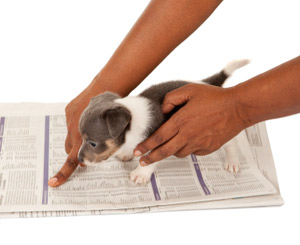
People who choose the paper training method often do so because they know the puppy will not have outside access as often as he will need to eliminate. While some dog owners find success with this method, it can be confusing to the dog. Paper training teaches the dog to eliminate inside, and later he/she will need be trained to relieve him/herself outside. Once a puppy is accustomed to eliminating indoors, it can be very difficult to deter him from this habit.
Crate training is a great choice for a dog who has accepted his/her crate as a place for sleeping. Since dogs don’t like to eliminate in the same spot where they sleep, he will be anxious to leave his/her crate and head outside when he/she needs to eliminate.
The first step in successfully crate training a puppy is to commit to a regular routine for taking your puppy outside. This way your puppy can learn that his/her chances to eliminate occur on a schedule. The trips outside should include first thing in the morning, at least once every hour during the day, and right before bedtime. After you’ve taken him/her outside, give him/her some play time before placing him/her back in the crate. During the times between trips outside, keep a close eye on your puppy and carry him outside if you see any indications that he/she is about to eliminate.
Keep in mind that accidents will happen, and that for many dogs, housetraining can take upwards of six months. No matter which method you choose, be faithful to it. Housetraining success is achieved by consistency and a lot of patience!
Leash Training
Taking a walk can be a fun time for both you and your dog. But if your dog does not know how to walk properly on a leash, it can be a frustrating and tiring event. Teaching your dog to walk nicely on a leash when he/she's a puppy can save you a lot of aggravation both while he/she's young and when he/she's older. This is especially important when you have a big dog. For example being dragged down the street by a 45 kilogram Rottweiler would probably not be considered a very relaxing or fun walk.
The first things you'll need are a leash and a collar. There are many different kinds on the market today, so you'll need to decide which one is most appropriate for your dog. Leashes come in several different materials, including leather, cotton, and nylon. Stay away from leashes made of chain, as they can tear the skin on your hands if your dog makes a quick dash after a cat or a car.
Two meters is a good length for a leash. There are also retractable leashes, which allow your dog from 5 to 8 meters of roaming room. Retractable leashes can be good for walks in the park because they allow your dog a little more freedom, but be mindful of the fact that not everyone likes dogs or wants to be greeted by your dog, so bring him/her back to your side if a person is approaching.

Some leashes come with a built-in collar. If yours does not, a flat nylon or leather buckle collar should do the trick. Some dog owners prefer a harness over a collar. A harness is a good choice if you plan to use some sort of seat belt system in your car instead of confining your dog to a crate. However when you're taking him for a walk, harnesses provide less control than collars. If you do decide on a harness, make sure it's a good fit for your dog, as a harness that's too loose or too tight can rub against his fur and cause sores.
So, now that you have the appropriate accessories, it's time to hit the road! Start with your dog standing next to your left leg. The traditional heel position used by most handlers places the dog on the left side of the owner's body. This is a good place to start and should be maintained until your dog has mastered walking nicely on a leash. However eventually you may not care whether he/she is on your left side, right side, or out in front of you. If he/she is hesitant to stand where you want him/her to, encourage him/her with a tasty treat, and reward him/her when he/sher is in the correct position. Now that he/she is standing at your side, show him/her another treat, and hold it just above his/her nose, at a height where his/her head is up and he can nibble the food without jumping. Say his/her name, and give the command you've chosen for walking, and begin to walk forward. As you walk, watch the leash, and if it begins to tighten, stop walking. Your dog should come to an abrupt stop as well. Stay still, lure him/her back to position with the treat, and resume walking. Over time, he will begin to consistently walk nicely on the leash, and rewarding with treats should no longer be necessary. Teaching a dog to walk nicely on a leash takes time. Be consistent and patient. You'll have a lifetime of long, leisurely walks together to look forward to.
Obedience Training
Trying to control a dog that hasn't learned obedience commands is exhausting and often near impossible. Really, dogs don't speak any human language. So how can we expect them to communicate with us if we haven't provided any vocabulary for them? Teaching four simple commands to your puppy or dog will make a world of difference and provide a great opportunity for bonding.
Keep in mind that puppies have short attention spans, and it is unreasonable to expect to have your puppy's full attention for a long period of time. Inside or outside, there are so many distractions, so keep your training sessions very short at first, gradually increasing the amount of time spent each day.
 Sit!
Sit!
Sit is a very important command for a dog to learn. It will provide a quick means for you to gain control of your dog in any situation. One of the easiest commands to teach, it should be taught early on, using the following method:
Put your puppy on leash, and have him stand in front of you. With the leash in one hand and a treat in the other, show your puppy the treat by holding it slightly above his nose. As he raises his head to take the food, slowly move the treat upward and backward toward his tail, keeping the treat directly above his nose. Your puppy will automatically sit as he tries to follow the treat with his eyes and nose. As soon as his hips hit the ground, say "Sit!", and praise him/her and give him/her the treat.
Down!
Down is another useful command and also very important for a puppy to learn early on. It can be a little more challenging to teach, but don't give up! With a little patience, your dog will learn the Down command in no time. Follow these steps:
Kneel on the floor so you and your puppy are at eye level, and hold a treat in one hand. Let the puppy sniff the treat, and slowly move it down toward the floor between his feet. Your puppy should plant his/her front feet and automatically fold his body into the Down position. Once his/her elbows and belly are on the ground, give the Down command, and then praise him/her and give him/her the treat.
Stay!
The goal of the Stay command is to teach your dog to hold the position of a particular command, such as Sit or Down. Avoid using the Stay command when you really just want your dog to wait, like if you're heading into the house and you want your dog to wait outside. This can cause confusion, as you probably just want him/her to remain in the general vicinity where you've left him/her, not like a statue in one position, as the Stay command implies. To teach your dog to stay, follow these steps:
Start with your puppy on a leash, sitting beside you. Tell him/her to Sit and to Stay, putting your open palm in front of his/her nose. Once he has remained still for a few seconds, praise him/her and give him/her a treat. Most dogs will only be able to hold the Stay position for 5 or 10 seconds at first. However, over a number of sessions, you can begin to increase the stay time. Once your dog is able to stay for 10 seconds or more, begin to move away from him/her, a little farther each time.
Come!
When you use the Come command, your puppy should come running to you immediately, without hesitation. In order to ensure this throughout his/her lifetime, it's important for the teaching of this command to include fun games and treats. Some owners make the mistake of only using this command when it's time to get in the crate or do something else that might not exactly excite the dog. If that's the case, he/she will quickly learn that the Come command indicates the end of his/her freedom, and he/she will probably ignore you the next time you call. So grab some tasty tidbits and a toy or two, and follow these steps:
Show your dog a treat or toy, and then toss it for him/her to fetch. As he/she runs for it, head in the opposite direction, and get out of his/her line of sight. Then, enthusiastically say your puppy's name. When he/she finds you, reward him/her with praises, kisses, and lots of love! Repeat this game several times every day, but not enough to bore your dog. Eventually, he/she will learn to automatically run to you every time you call his/her name. Teaching your dog obedience commands provides a way for you to easily communicate with him/her, and once he/she's able to understand and obey, you will find that your life and his/her are much more enjoyable.
Socializing
Introducing your dog to different sights, smells and sounds can make your dog feel at ease in various situations.
Puppies are capable of learning at an early age and, like children, they form lasting impressions, tendencies, and habits during this time. It can be a make-it or break-it time for your pup when it comes to his behavior. A puppy that is exposed to a variety of sights, sounds, and experiences during this early period will be more likely to develop proper socialization skills and grow into a happy, healthy, well-behaved older dog.
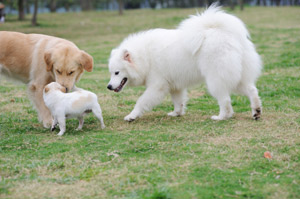
Generally, important socialization skills are learned when a puppy is between 8 and 16 weeks of age. If you are not diligent in exposing your puppy to new people and places during this time, he is likely to suffer in the long run. As soon as your new pup has reached at least 8 weeks of age and been properly vaccinated, the socialization process can begin.
A simple way to get started is to take him/her for a walk. If your neighborhood is especially loud or crowded, you may want to take him/her to a park instead. It’s important that the environment for his/her first socialization is fun, safe, and stress-free, so your puppy feels comfortable smelling, exploring, and interacting. By taking a walk together, you can expose him/her to a wide variety of people, animals, and other things at one time.
When other people show an interest in your dog, let them pet him/her so he/she can get used to different touches and smells. It’s also a good idea to carry extra treats with you so some of the people you meet can feed your puppy a snack, which should help to rid him/her of any fear of strangers. When your pup is nose-to-nose with another dog for the first time, keep both dogs leashed, and make the introduction slowly and carefully.
During early socialization, your puppy should also get a chance to hear different sounds, such as jingling keys and clapping hands, and smell different scents, such as grass, dirt, and other dogs. He/she should also be exposed to a variety of sights, like people wearing sunglasses or baseball hats, garbage cans, and moving cars. All exposure is good for your puppy during this formative period, to help alleviate his fears and ensure his/her comfort in just about any situation.
Keep your puppy on a leash at all times during the walk, and during other socialization activities. This will allow you to keep him/her close to you and protect him/her if necessary, and he/she will sense this protection and feel more safe and secure. However, it’s also important not to spoil your dog or reward fearful behavior. If you notice that he is fearful in a particular situation, modify it until he/she feels more confident. For example, if he is fearful when surrounded by a group of children, try to limit his contact with children to one child at a time until he/she is more confident.
Socializing your puppy can be time consuming, but it should be well worth it in the end. With some dedication and patience early on, your pup should mature into a well-rounded, well-behaved older dog.
Problem Solving
Sometimes dogs can develop problem behaviors that require your attention, such as chewing, digging, barking and jumping. You should learn how to spot these types of behavior and how to revert your dogs behavior back to normal.
Sometimes dogs can suddenly exhibit problem behaviors. Even dogs that are otherwise always on their best behavior can exhibit problem behaviors. Since dogs have no sense of morality, they don't do one thing because it's "wrong" and another thing because it's "right." They just do whatever works for them. For example, if you see your dog chewing on a chair leg and give him/her a cookie to distract him/her from the furniture, you have taught him/her that the next time he/she wants a cookie, all he/she has to do is find a good piece of furniture to gnaw on.
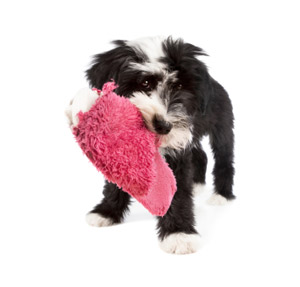
The following are some common problems:
Chewing
All dogs need to chew. For puppies, it is one way of exploring the world around them and can also use up some of their indefatigable energy; for older dogs, chewing may result from anxiety or boredom. Another common reason that dogs are chewers is simply that they enjoy it. Because it is impossible for a puppy to determine what is acceptable to chew on and what is not, he/she must be supervised whenever possible. When you see him/her starting to chew on something, say"No!" and give him/her something else to gnaw on. When he/she has to be left alone for a period of time, confine him/her to his/her crate along with appropriate chew toys.
Digging
For dogs, the urge to digging is innate—they just can't help themselves. So how can you keep your yard (or living room carpet!) from ending up with a bunch of holes in it? One approach is to provide your dog with a place where it's okay for him/her to dig, like a small sandbox in the backyard. Just keep in mind that digging is a natural behavior for dogs. With some supervision, you may be able to protect certain sacred areas from digging paws, but for a dog to dig is normal behavior and really shouldn't be punished.
Excessive Barking
Dogs bark for a variety of reasons, including excitement, protection, and aggression. However, dogs also bark to get attention. If your pup is using his/her bark to get attention, ignore him/her until he/she quiets down, and then calmly pet him/her. If you yell at a barking dog, he/she may think you are joining in and want to help him/her make a lot of noise, which will only encourage this unwanted behavior. Yelling at him/her is also giving him/her what he/she wants: attention.
One method sometimes used to conquer an excessive barking habit is to use a shaker can. A shaker can is just an empty soda can filled with a few coins or small pebbles. The next time your dog starts barking, give him/her a command, such as No Bark, and shake the can. The noise should startle him/her and distract him/her from his barking. Once he/she has stopped barking, praise him/her and reward him/her with a treat.
Jumping Up
When we are reunited with old friends or make new acquaintances, it is customary to shake hands, hug, or give a kiss on the cheek. For most dogs, jumping up is simply a type of greeting. If you do not want your adult dog to greet people in this way, discourage the behavior when he/she is a puppy.
When you see your puppy coming to greet you, get down on your knees and make a fuss over him/her. As you're doing this, put your thumb in his/her collar under his/her chin, applying gentle pressure so he/she can't jump up. Praise him/her only when all four of his/her paws are on the ground. When you have visitors, make sure your puppy is on a leash before you open the door. This will enable you to control his/her behavior without having to have your hand on his/her collar.
When your dog begins to exhibit a problem behavior, try to work on correcting it right away. The longer you let it go on, the harder it will be to correct it. Some problem behaviors get to the point where they are almost impossible for the average owner to handle. If you think your dog may need the kind of help that you can't give him/her, don't hesitate to seek the help of a professional trainer.
Separation Anxiety
You’re preparing to leave your house. You head for the door and pick up your keys along the way. The moment your keys give a little jingle, your dog is at your side, barking incessantly (with some howling thrown in for good measure). It almost seems like he knows you’re leaving and he/she’s trying to block your path to the door. Separation anxiety is one of the most common canine behavioral problems. It is estimated that about 15 percent of dogs in the United States suffer from this problem. A dog with separation anxiety will become extremely distressed when he/she realizes that you are about to leave home. Once you’re gone, he/she may howl, bark, urinate, defecate, or otherwise wreak havoc throughout the house. If your dog is misbehaving, either when you’re getting ready to leave, after you leave, or at both times, consider the possibility that he may have separation anxiety. As tempting as it might be to get upset with your dog, you should take a moment to consider what the underlying causes might be.
First of all, your dog may be afraid that when you leave you will not return. If your dog was previously abandoned, he/she will be especially susceptible to this fear. Another cause might simply be confusion. If you spent a few weeks at home with your new dog or were home for summer vacation, for example, your dog will have gotten used to spending time with you. If you return to work or are away for any reason for an extended length of time, your dog will be confused by this unexpected alone time and will perhaps think you’re not coming back. In both of these situations, it may take a while for him/her to learn that you haven’t permanently left him/her.
How can you help a dog that is suffering from separation anxiety? Try to work on gradually desensitizing your dog to being left alone. First, discourage him/her from following you around the house when you are home by giving him/her something to occupy his/her time, like chewing on a bone. You can also periodically jingle your keys or jiggle the doorknob without actually leaving the house so your pup stops associating these actions with being left alone. When it’s time to leave the house, don’t make a big deal about it, but simply walk out the door without looking at him/her. It may also help to leave the television or radio playing while you’re gone so the house is not completely quiet.
An additional way to help rid your pup of separation anxiety or to keep him/her from developing this problem in the first place is to teach him/her some basic obedience commands. When your dog has gained some skills, he/she will be more confident and will naturally lose some of his anxiety.
If you feel like you’ve tried everything and your dog is still exhibiting significant problem behaviors, you made need to seek the help of a professional. They can work on behavior modification with your pet and prescribe medication if necessary. Leaving your dog home alone should not be a traumatic experience for you or your pet. Don’t be afraid to seek professional help to assist your dog in overcoming this problem.
Dogs and Travelling
So what's better than going on vacation? Going on vacation and taking your dog with you! In order to have the most fun when travelling with your dog, there are a few things you should take care of ahead of time.
So what's better than going on vacation? Going on vacation and taking your dog with you! In order to have the most fun when travelling with your dog, there are a few things you should take care of ahead of time.
Before it's time to step on to a cruise ship for a few days or climb on to a plane for a few hours, you should make sure your dog is accustomed to his/her travel crate or bag. If your dog feels at home in his/her crate or bag, he should have no trouble adjusting to his travelling circumstances, no matter what they are. If you're lucky, he'll curl up and fall asleep for most of the ride.
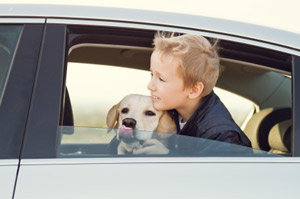
Decide in advance what items your dog will need for the trip. Some basic things you should have with you when travelling with your dog, include food, water, a collar, his leash, some treats, a pooper scooper, and a small first aid kit. It's also a great idea to bring a picture of your pup, in case he/she gets lost.
During your trip, it's very important that your dog gets the opportunity to relieve himself whenever possible. He/she shouldn't be deprived of water or food. Be respectful of other people and places by cleaning up after your dog and keeping him/her leashed.
If you're travelling in a car in the summertime, make every effort to never leave your dog in the car. If you must leave him/her there for a short period time, make sure the windows are open to provide some ventilation. Once you're on the move again, either close the windows or keep your dog in his/her crate to prevent possible injury to his eyes or ears.
By preparing yourself and your dog ahead of time, taking a vacation together can go off without a hitch. And don't forget to have fun with your dog and enjoy the time together!
Dogs and Cats
Many people think dogs and cats cannot live peacefully together. In fact, someone once coined the phrase “fighting like cats and dogs” and there is obviously some truth to the statement, as it’s been around for a while. Well, it’s true that some dogs and cats will not make good housemates. They are two different animals with two different distinctive personalities that will not necessarily blend. However, under the right conditions, many dogs and cats can live together in perfect harmony.
The majority of dogs can happily coexist with a cat if they are given time to comfortably get to know each other. If a puppy and kitten are raised together, they generally will learn right away to tolerate each other, and some cats and dogs grow to be real friends, even playing and napping together. However, if a cat is already an established member of the household and a new dog or puppy is going to join the family, certain precautions need to be taken.
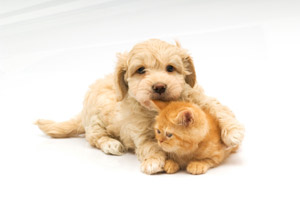
When you first introduce a cat and dog, make sure the cat is at the dog’s eye level. You should also keep a firm grip on both animals. This will make them feel more comfortable and provide them with a sense of security. If one of the animals seems either aggressive or frightened, immediately remove the dog and try again at a later time. You don’t want to force the situation by pushing them before they’re ready. This will only make matters worse. If you take a few minutes several times a day to give the cat and dog this carefully supervised time together, you should soon see them feeling more relaxed around each other.
Never leave a cat and dog alone together until you are certain that they are comfortable with each other. If you walk away while they are still checking each other out, you may be sorry when you return. The cat or dog could be scratched or bitten or otherwise injured. Even if there are no visible wounds, an unsupervised interaction like that could traumatize an animal so badly that he remains terrified of other animals for the rest of his life.
If you are ready for a new puppy or dog to join your family, help your cat get accustomed to the idea, too. Under strictly supervised conditions, allow the cat and dog to sniff and inspect each other to their hearts’ content. This interaction should get them used to each other in no time.